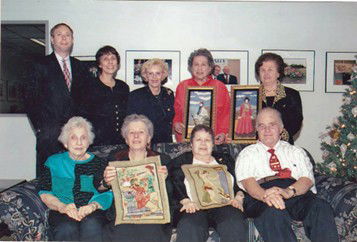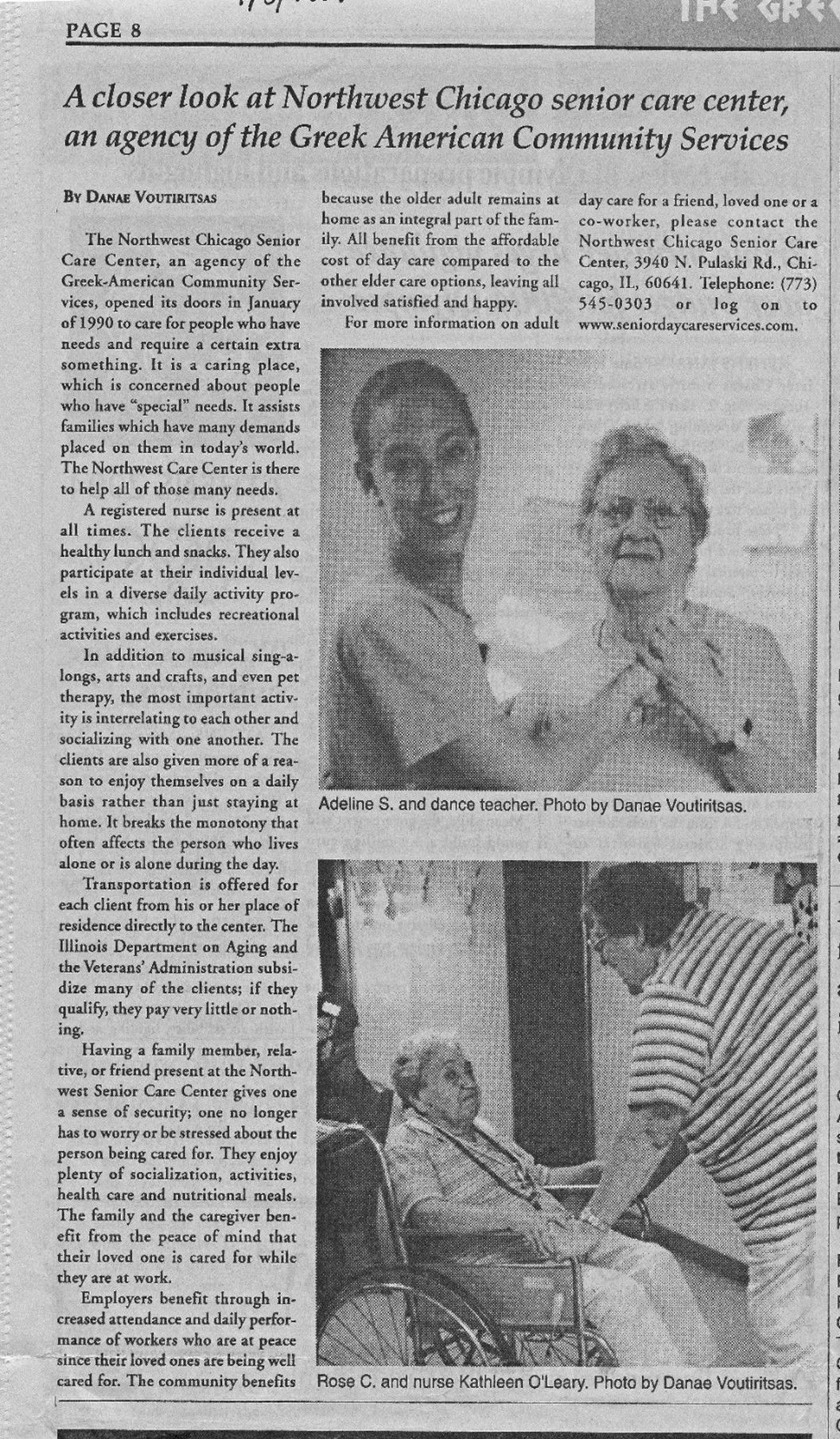The Check Isn’t in the Mail
From Working to Preserve Our Heritage: The Incredible Legacy of Greek-American Community Services
"Tuesday, September 11, 2001, started like any other day. It was a sunny morning, and I was leaving home to pick up two of our adult day care clients on my way in since one of the vans was in the shop for repair. After seeing the first plane fly into the World Trade Center. I remember running to the car so I could turn on the radio to hear the latest. While in the car, the second plane hit. By the time I had picked up the clients and driven to the center, the participants and staff were glued to the television.
We watched this tragedy unfold together and collectively experienced raw emotion and disbelief at what we were watching. I remember standing outside of the center and being aware of how eerily quiet things were. Being on a flight path, it was eerie to not hear a single airplane in the sky and only a few cars on two usually very busy streets. Within hours, the city was blanketed in American flags displayed from countless windows, rooftops, buildings, and vehicles. GACS proudly displayed American flags in our windows and on each Ya’Sou van. I do not recall if GACS closed for any time as a result of this attack, but it is likely that it did.
The tragedy and its aftermath caused further delays in government payments to vendors making it even more difficult for service providers to survive. We did better than some because our adult day care center had a more diverse client base. We also had private-pay clients who paid the full rate (rather than the state’s subsidized rate) and VA clients. The VA paid promptly. We also had grants and thus a better cash flow than some of the other centers. Nonetheless, there were limits to what any organization could endure over a prolonged period, and we were reaching our breaking point.
A special GACS fundraising appeal dated September 14, 2001, described our plight, and the impact delayed payments were having on GACS and other centers throughout the state:
For over a decade, Northwest Chicago Senior Care, the adult day care center operated by Greek-American Community Services has played an important role in the lives of frail, isolated, and forgetful older adults and the families who care for them. Perhaps the following letter by Mrs. Adory Ramos, a registered nurse by training and daughter of one of our recent participants can best illustrate the effect we have on those we serve.
‘My Dad died February 28, 2001. He was 92 years old. He lived with my family and me for the last 5 ½ years of his life. It’s unbelievable how much we miss him, and we console ourselves with the knowledge that he lived a full, wonderful life. It was very sad to see him getting weaker and frailer as he advanced in years, but we know the days he had spent at the day care added life to his years. He enjoyed it so much that not being able to go (during inclement weather and long holiday weekends) was like a punishment for him. He looked so much forward to going every day! Even when I’d see him not looking well, he’d insist on going because he did not want to miss the activities (especially Bingo!) and the exercises.
Sorting his things after he died was particularly painful but gave me a lot of reasons to smile too. Seeing all of the mementos from the day care, like his Bingo prizes, his projects, and the different certificates (for Father’s Day, Best Athlete, Best in Jeopardy, and every conceivable certificate) that only showed how the day care made every effort to make him feel important. And important he definitely felt. He’d wave his certificate or show me his Bingo prize as soon as he got off the bus! He was like a little boy coming home from school who couldn’t wait to show his family his great accomplishments for the day. For that blessed joy, for him and for us, we are eternally grateful.’
This letter is one of many we have received over the years from grateful caregivers and valued clients. Each letter speaks to the vital role our facility has played in the life of an older loved one or a concerned family member. Through the health care services, activities, recreational programs, socialization, exercise, meals, physical therapy, and transportation offered to our participants, we have often been an instrument in preventing or delaying nursing home placement or costly in-home care and in turn, have endeavored to ‘add life to the years’ of those we serve.
The demand for senior day care is expected to grow at double-digit rates in the coming years as older adults, due in part to modern medical advances, live longer but require more assistance with daily activities. Likewise, the aging baby boom generation will soon begin to require these services. Those who are enrolled in our program typically require much more personal care and specialized assistance than just five years ago. Despite these increased needs, funding has remained an ongoing and critical concern.
The majority of our participants are enrolled through the Community Care Program (CCP). In essence, this means they are of a low-income status dependent mainly on their social security or a pension to get by. They range in age from 60 to 97 and are affected by a variety of ailments, mobility impairments, or disorientation. They cannot be left home alone while their families work as they may risk injury, wander out of the house unattended, over or under-medicate themselves, forget to eat lunch, fall, or experience other incidents resulting from their physical or mental conditions. If it weren’t for our center, the caregiver would either have to quit his/her job or seek costly long-term care or in-home care options. In-home service does not offer the socialization, health care, and sense of purpose that adult day care offers.
Today, adult day care programs throughout the state are in crisis. Last year alone, 12 Illinois centers were forced to close. In May 2001, another two centers shut their doors. By year’s end, it is expected that over 7 percent of the remaining 94 centers will also cease operations. This is a direct result of inadequate funding from the Illinois Department on Aging’s Community Care Program. On average, state funding covers less than two-thirds of the actual cost of care for an older adult and does not take into account rising costs in these uncertain economic times. Since 1990, our center has served as a valuable resource for Northwest side families seeking relief, peace of mind, and support as they undertake the difficult emotional, and time-consuming process of caring for an aging loved one. In light of these circumstances, we write to ask for your support to enable us to continue to offer this vital service to a very underserved population. Your donation of at least $100 will help us to sustain this program during these very challenging times and enable us to continue working towards self-sufficiency.
In October, Elaine and I joined Fabric Arts participants who had their work on display in the atrium of the James R. Thompson Center State of Illinois Building and met with Illinois First Lady Laura Lynn Ryan to show her a few pieces of their works. During the photo op, Elaine and I told Mrs. Ryan about the problems we and other providers were having collecting payments from the state and that these delays could force some providers to close their doors. I asked for her husband’s help. She appeared concerned, held my hand in hers, and said 'I will pray for you.' This was about a month after the 9/11 attacks, and I still remember the somber mood and increased security that permeated the building and how subdued everything seemed compared to the usual hustle and bustle one usually encountered in the State of Illinois Building.
We were very fortunate. Our team cared and remained even if they weren’t being paid on time. Ann and Lorraine were both retired and had other sources of income, so they waited. Maria shifted some hours over to the nursing home and eventually expanded to full-time there once the nursing home opened. John worked for the Chicago Department of Aging and had the option to take on substitute teaching jobs to fill any gaps. We always made it a priority to pay Ray first so that he could pay his rent to the Irving Park YMCA.
This situation continued into November, and we were told there was little chance that we would see payment of any kind from the state until the following February, at the earliest. I was worn out at every level and did not want to endure any more of this. I was tired of telling people they couldn’t get paid and hiding from the landlord. Despite our best efforts, we were powerless to change anything to get paid sooner. After 16 years, I resigned from the position of executive director.
John, with agreement from the board, asked Danae Voutiritsas to take on the executive director’s role and she accepted. I thought John and Danae would make a great team. Elaine and I continued to help from the sidelines to the extent possible.
Given the financial conditions, the board opted not to renew the lease, and instead, GACS closed in the spring of 2002. Katherine Pischeck took the financial and client records. John took a lot of the files and other stuff to store in his garage. Unfortunately, these boxes went missing after a few years. I began a new position as senior services director at the Hyde Park Neighborhood Club, which was in the midst of a makeover. I purchased some GACS furniture to use there. John was able to sell both Ya’Sou vans through ads in the Chicago Reader. Twenty years later, John recalls that one was purchased by a band needing a van to travel cross-country.
About a month after GACS closed, checks started coming from the state. In total, nearly $40,000 came in within a relatively short period. Board meetings were held in the boardroom at Midwest Bank or Little Mike’s Restaurant. The board ensured that to the extent possible all debts were paid and then dissolved the organization.
GACS came to an end but there was little time to rest…the nursing home was about to open. As one set of doors closed, another was on the verge of opening."

Fabric Arts Program participants meet with Illinois First Lady Laura Lynn Ryan in the Governor’s Office. Seated (L-R): Emily Cotsirilos, Eugenia Stathakis, Phyllis Cain, and John Dubrovin. Standing: John Psiharis, Elaine Thomopoulos, Laura Lynn Ryan, Beaula Iatropoulos, and Frieda Aravosis. October 2001. John Psiharis collection.

A profile of NCSC prepared by Danae Voutiritsas that appeared on the back page of the Greek Star. Circa 2001. Elaine Thomopoulos collection.